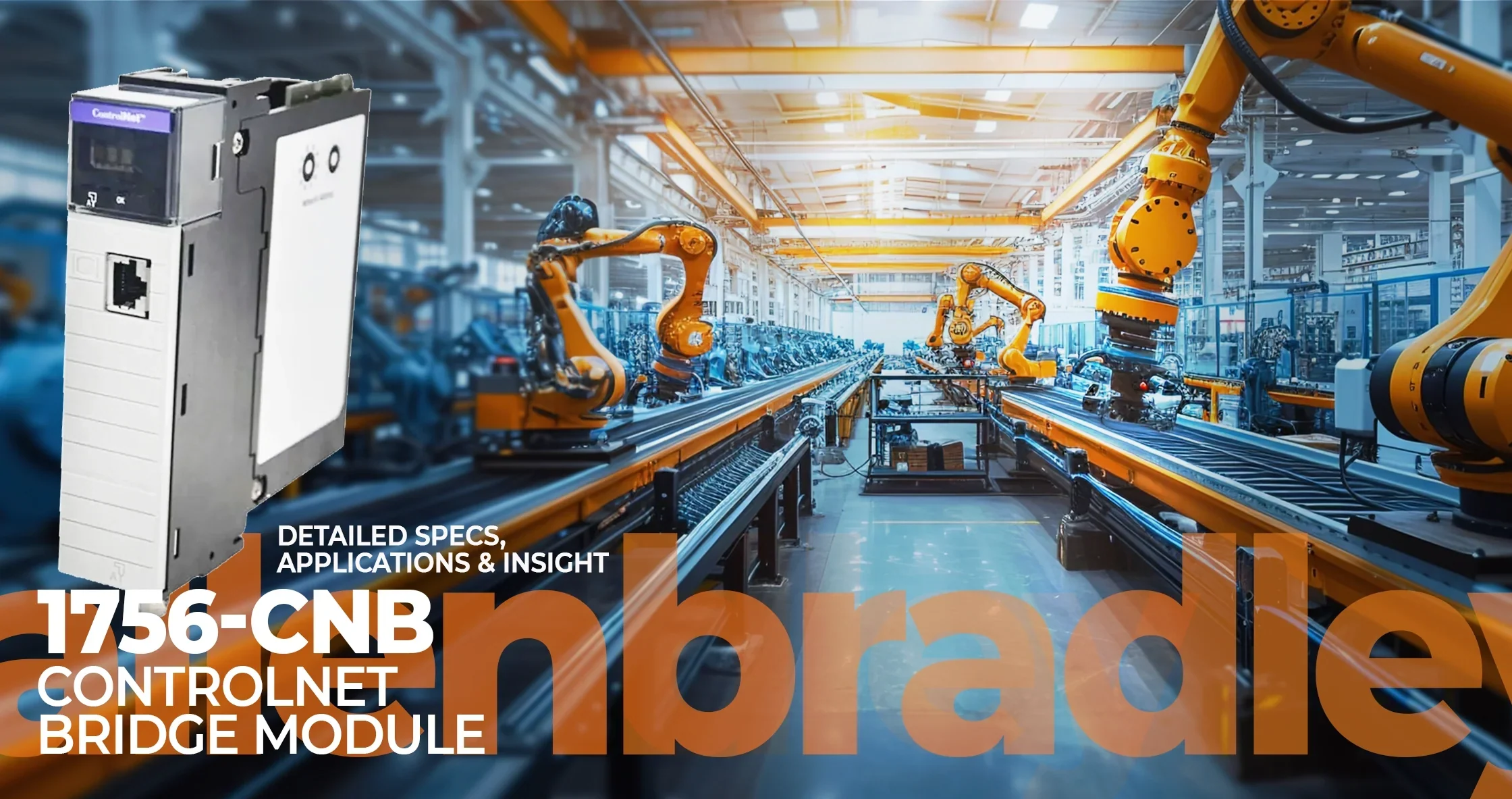Introduction
The Allen-Bradley 1756-CNB ControlNet Bridge Module is a critical component in industrial automation, enabling seamless communication between ControlLogix systems and ControlNet network. Designed as a nonredundant interface, this module is known for its reliability, deterministic communication, and scalability in complex automation environments. In this blog, we’ll dive deep into its specifications, explain why each feature matters, and provide real-world industry applications where the 1756-CNB has played a vital role.
What is the Allen-Bradley 1756-CNB ControlNet Bridge Module?
The Allen-Bradley 1756-CNB ControlNet Bridge Module is a communication module from Rockwell Automation’s ControlLogix family. Its purpose is to bridge a ControlLogix chassis to a ControlNet network, allowing for high-speed, deterministic, and synchronized data exchange. ControlNet itself is a fieldbus network that operates at a fixed rate of 5 Mbps, ensuring predictable performance in mission-critical environments.
This module is particularly useful in large-scale distributed control systems, where synchronization and timely data exchange are essential.
Key Specifications of the Allen-Bradley 1756-CNB ControlNet Bridge Module
Module Type and Role
● Specification: ControlNet Bridge / Interface (Nonredundant)
● Explanation: This identifies the module as a communication interface. Unlike redundant versions (such as the 1756-CNBR), it provides a single connection path to the network. Nonredundant operation is ideal for applications where fault tolerance is not critical.
ControlNet Port and Speed
● Specification: 1 ControlNet BNC coax connector, fixed at 5 Mbps
● Explanation: The fixed speed ensures deterministic communication. This consistency is critical in automation because devices can synchronize data updates without jitter or unexpected delays.
Supported Network Nodes
● Specification: Up to 99 nodes on a single ControlNet segment
● Explanation: This capacity allows large-scale integration of devices—controllers, remote I/O, and HMIs—on one network. It makes the 1756-CNB suitable for industries like automotive and oil & gas, where multiple subsystems must communicate reliably.
Logix Communication Connections
● Specification: 40–48 typical connections, 64 maximum
● Explanation: These connections include produced/consumed tags and message instructions. The connection capacity dictates how much data can flow simultaneously. If an application requires many connections, planning around these limits is crucial.
Power Consumption
● Specification: 970 mA @ 5.1 VDC, 1.7 mA @ 24 VDC
● Explanation: Power requirements ensure compatibility with the ControlLogix chassis backplane. Designers must factor in current draw when calculating rack power budgets to avoid overloading.
Power Dissipation
● Specification: ~5.1 W (17.4 BTU/hr)
● Explanation: This defines how much heat the module generates. Proper ventilation is necessary to maintain reliability and extend component life.
Isolation and Insulation
● Specification: 30 V continuous (basic insulation)
● Explanation: This provides protection between the ControlNet network and the backplane. While it offers basic isolation, additional grounding and shielding practices are recommended in high-noise environments.
Environmental Specifications
● Operating Temperature: 0 to 60 °C
● Storage Temperature: –40 to 85 °C
● Vibration Resistance: 2 G @ 10–500 Hz
● Shock Resistance: 30 G operating
Explanation: These specifications ensure that the module can withstand harsh industrial conditions, including extreme temperatures, vibrations from machinery, and physical shocks.
EMC / Immunity Ratings
● ESD Immunity: 6 kV contact, 8 kV air
● EFT/Burst Immunity: ±3 kV on ControlNet ports
● RF Immunity: 10 V/m from 80–2000 MHz
Explanation: These ratings highlight the module’s resilience in noisy electrical environments, ensuring that communication remains stable even near heavy motors or high-voltage equipment.
Form Factor
● Specification: 1-slot module, ~0.26 kg
● Explanation: The slim form factor makes it easy to integrate without requiring significant panel space.
Firmware and Series (E)
● Specification: Series E, firmware up to 11.x
● Explanation: Firmware defines performance and compatibility. Series E corrected anomalies from previous versions, including improved bandwidth reporting and synchronization.
For further details, Rockwell provides official ControlLogix Communication Modules technical documentation.
Why These Specifications Matter
Each specification is more than a number—it impacts real-world performance:
● Fixed Speed (5 Mbps): Guarantees deterministic behavior essential for process control.
● Node Capacity: Enables scalability for complex networks.
● Connection Limits: Ensures proper system design to avoid exceeding communication capacity.
● Power Draw & Dissipation: Impacts chassis selection, power supply planning, and cooling design.
● Isolation: Protects against ground loops and EMI, though basic isolation means extra care is needed.
● Environmental Ratings: Confirms the module’s suitability for harsh factory floors.
● Firmware Revisions: Address bugs and compatibility issues, making upgrades important for reliability.
Industry Applications of the 1756-CNB
Automotive Manufacturing
In automotive assembly lines, the Allen-Bradley 1756-CNB ControlNet Bridge Module connects multiple robotic stations, conveyors, and inspection systems into a synchronized communication network. The deterministic 5 Mbps speed ensures that all machines operate in perfect sequence.
Oil & Gas Industry
For offshore rigs and refineries, ControlNet is used to link distributed skids, pumps, and monitoring systems. The rugged environmental ratings of the 1756-CNB ensure reliable operation under extreme conditions.
Food and Beverage Processing
Factories with distributed I/O for packaging, bottling, and labeling use the 1756-CNB to tie remote modules together. This enables consistent production rates and real-time quality control.
Power and Utilities
Power plants rely on deterministic communication for turbine control, substation monitoring, and grid synchronization. The 1756-CNB’s fixed-speed ControlNet link provides reliability for such critical operations.
Legacy System Integration
Many facilities still operate legacy ControlNet infrastructures. The 1756-CNB provides backward compatibility, allowing modern ControlLogix controllers to integrate without replacing entire networks.
Advantages of the Allen-Bradley 1756-CNB ControlNet Bridge Module
● Deterministic Communication: Guarantees precise timing.
● Scalable: Supports up to 99 nodes.
● Reliable Performance: Series E firmware improved reliability.
● Compact Design: 1-slot integration simplifies panel layouts.
● Proven in Industry: Widely used in multiple sectors for decades.
Limitations to Consider
● Discontinued Product: Officially discontinued in December 2024. Spare parts availability may decrease.
● Nonredundant: For redundancy, the 1756-CNBR is required.
● Basic Isolation: Not suitable for environments needing high-voltage isolation without extra measures.
● Fixed Bandwidth: Heavy data loads may exceed capacity.
Comparison with Alternatives
● 1756-CN2: A newer generation with higher performance and expanded features.
● EtherNet/IP Modules (1756-EN2T, etc.): Preferred in modern designs due to scalability, speed, and ubiquity of Ethernet.
● 1756-CNBR: For redundant applications needing fault-tolerant communication.
Best Practices for Using the 1756-CNB
- Plan Network Topology Carefully: Stay within the 99-node limit.
- Monitor Connections: Avoid exceeding 64 total connections.
- Account for Heat Dissipation: Ensure proper ventilation.
- Keep Firmware Updated: Use the latest Series E firmware to avoid anomalies.
- Maintain Spares: Since discontinued, keeping a stock of factory-sealed units can reduce downtime risk.
Conclusion
The Allen-Bradley 1756-CNB ControlNet Bridge Module remains a cornerstone of ControlNet-based automation systems. Its deterministic performance, scalability, and rugged design made it a trusted choice across industries from automotive to oil & gas. While it has been officially discontinued, facilities with legacy ControlNet infrastructures continue to rely on it as a proven and reliable solution.
If you’re operating or maintaining ControlNet networks, the Allen-Bradley 1756-CNB ControlNet Bridge Module is an essential component worth understanding in depth. For more details on purchasing, specifications, or compatible upgrades, visit the product page and explore your options for ensuring long-term system reliability.
Related Product Collections You May Find Useful
Explore legacy and hard-to-find industrial automation components, perfect for sourcing spares like the 1756-CNB and other obsolete modules.
Browse a wide range of automation hardware, including PLCs, communication modules, and I/O systems, designed to keep your industrial processes efficient.
3. PLC’s / Network & Communication →
Find PLC cards, communication modules, and network hardware that complement ControlLogix systems and enhance connectivity in industrial networks.


